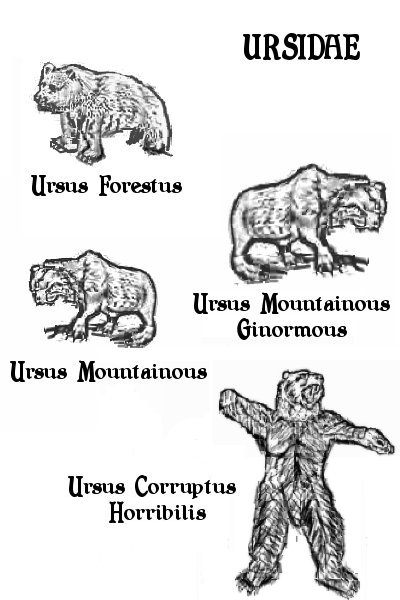|
Ursidae
Members of the family Ursidae, more commonly known as Bears, are widespread. They inhabit a wide variety of habitats from tropical to frozen wastelands. They belong to the larger group of Carnivora.
Typically bears have a large body with stocky legs, a long snout, five nonretractile claws, and a short tail. They walk on their entire foot (plantigrade), not just on the toes like other members of Carnivora. Their skulls are elongated, and their fur is dense and long. Bears can stand on their hind legs for extended periods of time and they tend to sit down on their rear with their upper body off the ground. From a distance, in low light, a bear doing either of these can resemble a human. There have been many Adventuous who have been unpleasantly surprised by the confusion.
With the exceptions of mating individuals, and mothers with their young, bears live alone. When running into multiple bears at once, it tends to be zealous, protective mother bears and their nearly fully grown offspring. Although their vision and hearing is not the best, bears have an excellent sense of smell, can run quickly, and are adept climbers and swimmers.
Most often, members of the Ursidae family are nocturnal or crepuscular, but may be active during the day as well. They tend to be omnivorous and opportunistic feeders - eating carrion, meat, or plants as the opportunity presents itself. If they're hungry and something is about, bears will generally try eating it.
Due to their size and varied diet, all bears impact the populations of animals and plants where they live. Bear species not only exert significant pressure on the populations of their prey but aid in the dissemination of seeds as well in their fecal matter.
Bear and Enraged Bear
(Ursus Forestus)
The Bear, sometimes called the Forest Bear, inhabits the area directly north of Dundee. An adult Forest Bear can easily fend off packs of wolves and other sizeable predators. While it may engage in threat display with humans, generally humans strike at it first. Made into a cloak or armor the bear’s skin is good protection against the cold and aids in blunting attacks.
Sometimes one of these bears will grow angry, perhaps from lack of food, affliction with a disease, or some other reason. At this time it is more antagonistic towards others and more likely to attack. Due to its rage, it is fiercer in its attacks and harder to kill.
Great Mountain Bear
(Ursus Mountainous)
The Great Mountain Bear’s feet are much larger than with other bears, making it easier to distribute weight on ice and snow. The soles of the feet have a suction-cup like surface enabling a firm grip on the slippery rock, snow and ice where they live. Each bear has a large territory which it travels in seeking food. There are extant two populations of Great Mountain Bears.
They do not appear to engage in territorial battles; however, when hungry they will attack just about anything. Their hides make excellent cloaks. Their specific interactions with the Centaurs of the area are unknown as they have sometimes been found in the same range.
Greater Mountain Bear
(Ursus Mountainous Ginormous)
The Greater Mountain Bear Ursus Mountainous Ginormous seems to be a subspecies of Ursus Mountainous grown to a larger size. For classification purposes it is combined with the Great Mountain Bear. They too travel within a limited range, but do not appear to attack other bears or grow too territorial…unless food is limited. The Greater Mountain Bear is the largest unmagical land carnivore discovered in Valorn to date. Males can exceed 800 pounds in weight. There is one extant population.
Warped Bear
(Ursus Corruptus Horribilis)
No one is certain of what subspecies Warped Bears once were. Perhaps they were Mountain Bears out of their range or even Forest Bears. Whatever they once were, they are no longer. The magic that caused the Black Wastelands changed them as well. Their movement appears more of a shamble that that of other bears, although they have a fast ground-coving lope when needed. They roam the Black Wastelands appearing unaffected by the limited hunting conditions.
The already elongated bear skull has been lengthened even more and the eyes appear more sunken in. They are also quicker tempered and more likely to gather in small groups. The pelt is useless for clothing or armor purposes as the skin has lesions and oozes.
 Simmer cubed bear meat (any type except the Warped Bear) in a heavy kettle for several hours with vegetables, spices, and wine. The resulting stew is hearty and filling.
Simmer cubed bear meat (any type except the Warped Bear) in a heavy kettle for several hours with vegetables, spices, and wine. The resulting stew is hearty and filling.

Baliana, on bearskin armor: "It is very nice and comfortable. Not heavy or bulky at all while providing great protection."
Valor Nilsus: "Hairy and strong. And it's best not to have any food in your pack when you're about them or they'll go through you just to get at it.”


by Purazon
|
|
 Simmer cubed bear meat (any type except the Warped Bear) in a heavy kettle for several hours with vegetables, spices, and wine. The resulting stew is hearty and filling.
Simmer cubed bear meat (any type except the Warped Bear) in a heavy kettle for several hours with vegetables, spices, and wine. The resulting stew is hearty and filling.


